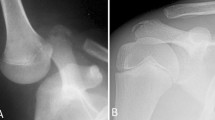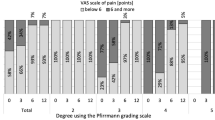Summary
57 patients who underwent surgery for slipped lumbar disc for the first time were examined prospectively 6 months after surgery for the purpose of deciding the correlation between the outcome of surgery and social and psychological factors. The following factors were found to be of importance: Female sex, action for damages, prolonged disease of the back; prolonged, current attack, report of long-term illness, pathological pain producing, anxiety, depression and multiple somatic complaints revealed by Minnesota Multiple Personality Inventory (MMPI)6, severe pain reported immediately post-operatively, employment and the presence of complete herniation at surgery.
A closer study revealed 3 factors which were important independently and which explained the other factors: Admission of symptom scale (Ad) in the MMPI, the duration of the current attack and whether the patient was employed. On this basis we define a group with severe psychological and social strain (PASS), 57% of which had a poor outcome. 5% of the rest of the patients had a poor outcome.
With the pre-operative assessment of whether or not the patients are under severe psychological and social strain, the outcome of surgery could be predicted correctly in 86% of the patients.
Similar content being viewed by others
References
Carlsson AM (1983) Assessment of chronic pain. I. Aspects of the reliability and validity of the visual analogue scale. Pain 16: 87–101
Dirks JF, Kinsman RA, Nelson JJ, Fross KH (1978) New developments in panic-fear research in astma: Validity and stability of the MMPI panic-fear scale. Br J med Psychol 51:119–126
Documenta Geigy (1970). Mathematics and statistics. Basle
Espersen JO, Kosteljanetz M, Halaburt H, Miletic T (1984) Predictive value of radiculography in patients with lumbagosciatica. A prospective study (Part II). Acta Neurochir (Wien) 73: 213–221
Foldspang A, Juul S, Olsen J, Sabroe S (1981) Epidemiologi. Sygdom og befolkning. Munksgaard, København, pp 1–218
Greene RL (1980) The MMPI. An interpretive manual. Grune & Stratton Inc, New York, pp 1–306
Gross AR (1986) The effect of coping strategies on the relief of pain following surgical intervention for lower back pain. Psychosom Medicine 48: 229–241
Herron LD, Pheasant HC (1982) Changes in MMPI profiles after low-back surgery. Spine 7: 591–597
Holmes TH, Rahe RH (1967) The social readjustment rating scale. J Psychosom Res 11: 213–218
Kleiger JH, Kinsman RA (1980) The development of an MMPI alexithymia scale. Psychother Psychosom 34: 17–24
Kosteljanetz M, Espersen JO, Halaburt H, Miletic T (1984) Predictive value of clinical and surgical findings in patients with lumbago-sciatica. A prospective study (Part I). Acta Neurochir (Wien) 73: 67–76
Little KB, Fisher J (1958) Two new experimental scales of the MMPI. J Cons Psychol 22: 305–306
Long CJ, Brown DA, Engelberg J (1980) Intervertebral disc surgery. Strategies for patient selection to improve surgical outcome. J Neurosurg 52: 818–824
Dostdam EMM, Duivenvoorden HJ (1983) Predictability of the result of surgical intervention in patients with low back pain. J Psychosom Res 27: 273–281
Ransford AO, Cairns D, Mooney V (1976) The pain drawing as an aid to the psychological evaluation of patients with low-back pain. Spine 1: 127–134
Berkeley LR (1984) A critique of the surgical management of lumbar disc disease in a private neurosurgical practise. Spine 9: 500–504
Roslund J (1974) Indications for lumbar disc surgery. Doctorial dissertation, Stockholm
Taylor WP, Stern WR, Kubiszyn TW (1984) Predicting patients perception of response to treatment for low-back pain. Spine 9: 313–316
Weber H (1983) Lumbar disc herniation. A controlled, prospective study with ten years of observation. Spine 8: 131–140
Author information
Authors and Affiliations
Rights and permissions
About this article
Cite this article
Sørensen, L.V., Mors, O. & Skovlund, O. A prospective study of the importance of psychological and social factors for the outcome after surgery in patients with slipped lumbar disk operated upon for the first time. Acta neurochir 88, 119–125 (1987). https://doi.org/10.1007/BF01404148
Issue Date:
DOI: https://doi.org/10.1007/BF01404148




